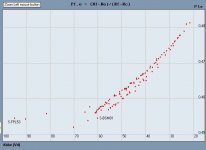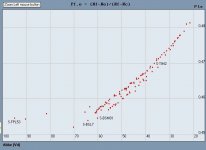AlanFrench
Well-known member
To an optician the term ED means Extra-low Dispersion. As you know, if you make a prism and pass light through it, it will break white light up into its component colors. The blue end of the spectrum is bent the most, and the red end is bent the least. The prism disperses or spreads out the colors that make up white light.
Dispersion is a simply a measure of how much the colors are spread out by the prism. A typical achromat is made of a low dispersion crown glass and a high dispersion flint glass. The recent advent of extra low dispersion materials, often called fluor-crowns, allows opticians to make two element lenses from a fluor-crown glass and a crown glass.
People often mistakenly believe the superior color correction of such doublets is because of the extra-low dispersion. That is incorrect. You could have an ED material that would provide absolutely no such advantage. Neither is such material classified as "abnormal dispersion" because of its extra-low dispersion. There is another characteristic that allows ED material to be used for better color correction (with the proper matching glass or glasses), and caused it to classified as "abnormal dispersion."
I'll leave it at that for now. In the meantime, see if you can find a glass diagram on the web (or look at the next post). Take a look at where the best ED glasses lie in relation to the crown glasses. Also note where the flint glasses lie in relation to the crown glasses. Keep in mind that designers want two glasses with substantially differing dispersions. Another hint - Ohara's FPL53 and BSM81 can be combined to make an absolutely superb apochromat, one that even meets James Baker's very stringent criteria.
I should mention that the horizontal axis of a glass diagram or glass map is the dispersion. Opticians usually use the reciprocal of disperson, so higher numbers mean lower dispersion. The ED material is usually to the left, and the flints are way to the right. FPL53 and CAF2 (fluorite) have a dispersion of 95.
Clear skies, Alan
Please see next post....
Dispersion is a simply a measure of how much the colors are spread out by the prism. A typical achromat is made of a low dispersion crown glass and a high dispersion flint glass. The recent advent of extra low dispersion materials, often called fluor-crowns, allows opticians to make two element lenses from a fluor-crown glass and a crown glass.
People often mistakenly believe the superior color correction of such doublets is because of the extra-low dispersion. That is incorrect. You could have an ED material that would provide absolutely no such advantage. Neither is such material classified as "abnormal dispersion" because of its extra-low dispersion. There is another characteristic that allows ED material to be used for better color correction (with the proper matching glass or glasses), and caused it to classified as "abnormal dispersion."
I'll leave it at that for now. In the meantime, see if you can find a glass diagram on the web (or look at the next post). Take a look at where the best ED glasses lie in relation to the crown glasses. Also note where the flint glasses lie in relation to the crown glasses. Keep in mind that designers want two glasses with substantially differing dispersions. Another hint - Ohara's FPL53 and BSM81 can be combined to make an absolutely superb apochromat, one that even meets James Baker's very stringent criteria.
I should mention that the horizontal axis of a glass diagram or glass map is the dispersion. Opticians usually use the reciprocal of disperson, so higher numbers mean lower dispersion. The ED material is usually to the left, and the flints are way to the right. FPL53 and CAF2 (fluorite) have a dispersion of 95.
Clear skies, Alan
Please see next post....
Last edited:





